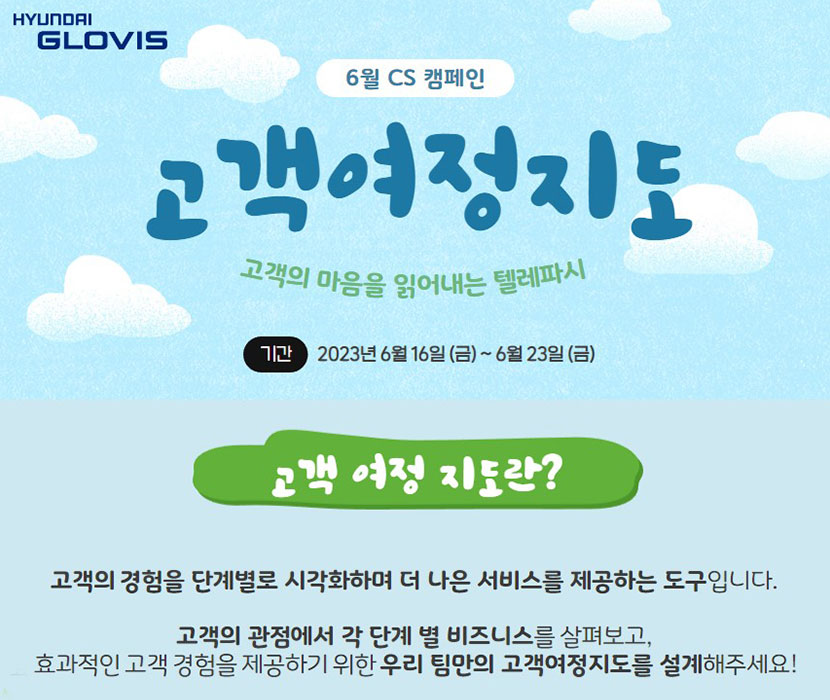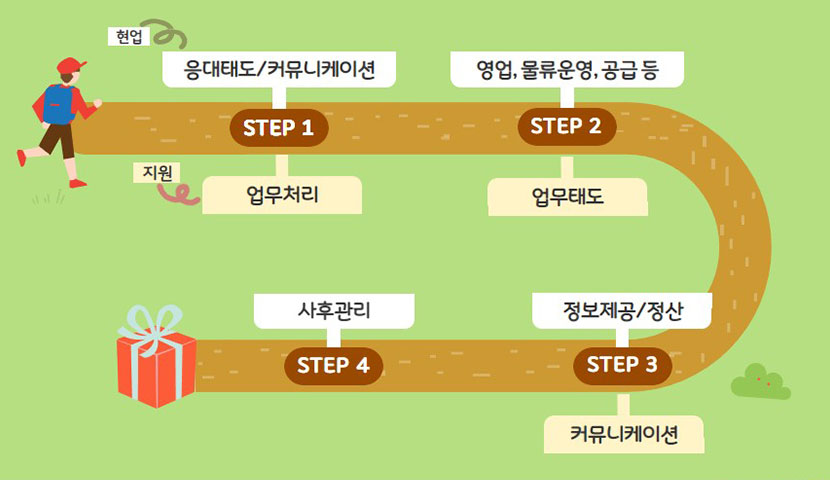How satisfied are customers with my team’s service? Can we deliver a more effective customer experience? Here’s how: Create customer personas to identify the exact customer touchpoints and create a customer journey map that delivers practical and efficient customer experiences! Let’s start by creating customer personas for your key objectives and drawing a customer journey map with customer experience at its core.
Create a map of the customer journey in the mind of the customer
EQ (Emotional Quotient) is becoming more important than IQ (Intelligence Quotient). According to futurists, psychologists, and entrepreneurs, empathy, or the ability to read other people’s minds, impacts the ability to communicate with others and perform work, making companies more competitive. This holds particular significance for customer service representatives who directly engage with customers. This empathy was the foundation of the CS Customer Journey Map campaign, which ran for a week from June 16-23. The Customer Journey Map is a tool that visualizes the customer experience step-by-step from the customer’s perspective to provide better service. In order to deliver a customer experience that truly resonates with our customers, it is imperative that we craft a customer journey map from their perspective. How can we draw a customer journey map that will keep our customers happy throughout the journey and get them to their desired destination safely?
Your customer is another you: creating a persona
To draw such a detailed and accurate map, you first need to know the mind of your customer. To do that, you don’t need a vague image of a “customer,” you need something more specific: a persona. A persona used to be a mask worn by a theater actor, but now it refers to a character, a person with a specific and unique image. In short, a customer persona is a character with the most unique and common characteristics that are representative of a ModernGlobis customer. These personas help us understand our customers’ needs, behaviors, and goals. So, analyzing and creating personas for our team in as much detail as a profiler was the first step in this campaign. Customer personas are developed to accurately capture the diverse characteristics of our team’s customers, encompassing their goals and need for a comprehensive understanding. The customer service campaign recognized the team that successfully established our team’s personas through precise analysis and examples. Building upon this foundation, they were able to create an effective and transparent customer journey map.
Use personas to paint the big picture of the customer journey
Once you’ve created your customer personas, it’s time to get inside their heads. First, identify and list your persona’s clear goals and needs by CS stage. Together, these steps will give you the first glimpse into your customer’s journey with Hyundai Glovis.
Create touchpoints that speak to the heart of your customers
To effectively guide customers from start to finish, customer journey maps demand a more nuanced approach. It’s a strategy that gives them confidence and reassurance so they don’t backtrack or get lost along the way. To do this, you need to add touchpoints along the way.
“Touchpoints” are the points of contact between Hyundai Glovis and the customer. In other words, we have categorized customer touchpoints for each CS stage by considering the customer satisfaction dimensions that customers value. It is very important to categorize the customer experience in detail to enhance the customer’s priority value. By categorizing the customer experience in detail, you can see where customers are more satisfied and where you need to listen to them more.
Touchpoints can be broken down by CS stage, as shown below. In which CS stages does my team interact most with customers, and what do our customers value most at each stage? Once you’ve identified your customer touchpoints, conduct a mid-year review at each touchpoint to ensure you’re delivering a positive customer experience in the first half of 2023.
What does the finished customer journey map look like?
Now that you’ve drawn the big picture, it’s time to map out your customer experience, or CS story, so that everyone can easily and happily find their destination. This is where the true voice of the customer comes in. Based on the cases where customers were satisfied and the cases where customers were dissatisfied, we identified the needs of the customers and made the final revisions. The customer journey map was created by weaving CS knowledge and customer experience into the threads and strands of the map. CS and customer satisfaction that accompanied the customer’s steps along the journey from beginning to end are bound to be successful.
What did you focus on when creating the customer journey map?
We used the results of our ’22 Years of Customer Satisfaction Survey’ to identify the strengths/weaknesses of our team and to ensure that we were reflecting the needs of our customers.
Do you think the customer journey map submitted for this CS campaign will help provide customer service?
I think it will be helpful because we guessed the customer’s feelings from the customer’s point of view and wrote the CS improvement plan and response plan accordingly. It is a material that can be seen at a glance where we need to focus to satisfy the customer.
With personas and customer journey maps in place, how do you see your team’s CS changing in the second half of the year?
As we follow the customer journey map, we will continue building on our strengths and filling in the gaps to sustain excellent customer satisfaction in the second half of the year. I think it will be a rewarding end to the year as we build deeper relationships with our customers.
What makes your team’s CS feature unique?
Our CS work is characterized by the need to provide optimal and customized services as our customers’ needs change. To do this, the safeguarding of know-how is essential.
What did you focus on when creating the customer journey map?
Our starting point was what the customer needs from the customer’s point of view. We defined CS as “the activity of finding answers at the customer touch point. We objectified our team from the customer’s point of view and thought about the customer’s needs. It was a great time for us to find out what our team was lacking in terms of CS and how we could improve.
Do you think the customer journey maps submitted in this CS campaign will help you provide better customer service?
Creating the Customer Journey Map is very meaningful in that it reviewed the current CS situation of our team and established the direction of customer service. Therefore, I think it will help us improve the quality of customer service. Also, this time we were able to come up with a concrete plan to increase face-to-face activities with customers, and in the future, we will provide differentiated customer experiences, such as accompanying customers on overseas business trips and visiting very large cargo ships.
How do you see your team’s CS changing in the second half of the year based on your persona/customer journey map?
In the second half of the year, I expect to see a shift towards ‘active engagement CS.’ We will go beyond responding to customer requests and actively present new ideas and try to convince customers to reduce costs and improve service quality. If we read our customers’ minds first and come up with creative solutions, I think we will be able to realize ‘moving customers beyond satisfaction’ (laughs).
By the Editorial Department
2023.07.18












